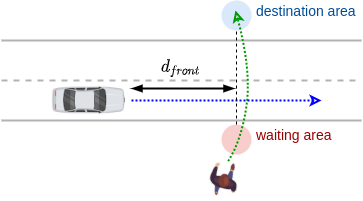Thank you Mr.Jakob
Let me briefly introduce my healthcare environment: individuals move with AGV. The AGVs are only to transfer materials in the environment (a flat floor) like the following picture. AGV might meet pedestrians who include: staff (S for short), visitor (V for short), patients - move like normal (N for short) and individuals with disabilities (D for short)
Therefore I need some improvement:
(i) in XML, the personFlow needs new attributes, for example: disable (a probability indicates the person is D or not). If a pedestrian is D type, he might have a stick or crutch or wheeled-chair or even he is bind.
(ii) In the intersection, D person (who has a slower velocity) might be carried by other S, V or even N people for crossing, especially as the D is moving in a crossway. After leaving the crossway, D person could be left alone.
(iii) A pedestrian will have different gap acceptance (a distance between person to the AGV). If the distance is too short, he/she would decide to stay at the waiting area.
The gap acceptance of a pedestrian depends on yielding of vehicle (too loud or not), healthy of the person as well as the number of AGV's platoon
Looking at the code of Omnet++ and SUMO, I still don't know which files to modify. If it is too difficult to change the code, perhaps I have no choice but to use a quick and dirty hack to get my purpose.
Thank you in advance

